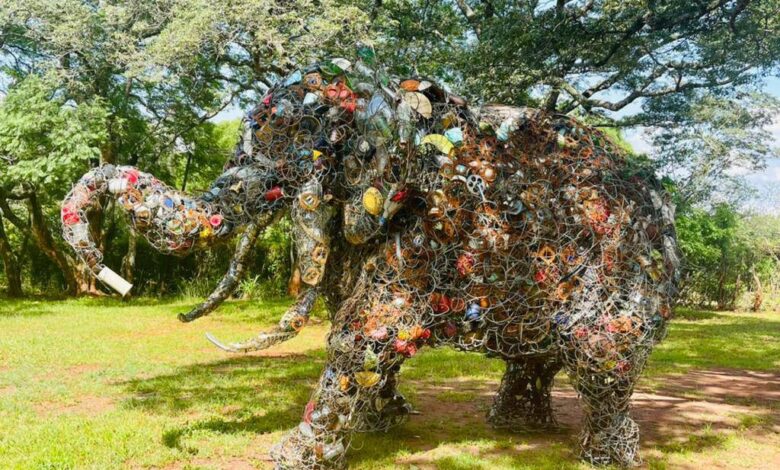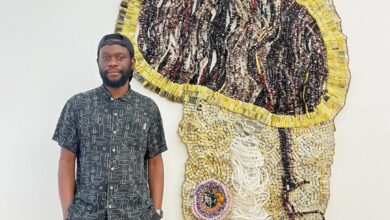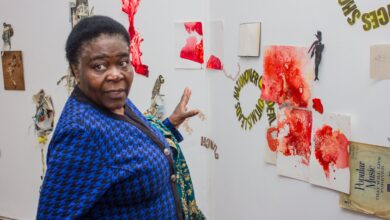The Artistic Fight Against Poaching: Johnson Zuze’s Eco-Conscious Creations

In the world of contemporary art, Johnson Zuze stands out for his powerful fusion of environmental activism and artistic expression. The Chitungwiza-based artist has spent nearly two decades crafting mixed-media pieces that are more than just artworks; they are calls to action in the fight against poaching and a push for greater environmental conservation. Zuze’s creations stand as stark reminders of the pressing need to protect endangered wildlife and preserve natural ecosystems.
The Art of Conservation
Zuze’s art is deeply tied to the conservationist movement. He draws inspiration from the need to raise awareness about the devastating effects of poaching, a crime that threatens the survival of iconic African wildlife. His sculptures are framed by snare wire—discarded remnants of traps used by poachers. These wires are given to him by conservation groups, and they come from regions such as Manicaland and Matabeleland North. Zuze’s choice to incorporate these materials into his work speaks to a larger narrative of repurposing and healing.
The wire itself is not just a material; it symbolizes the ongoing struggle against the illegal wildlife trade. Zuze’s sculptures, which include elephants, buffaloes, lions, and tiger fish, are not only artistic interpretations of these creatures, but they also serve as tributes to them. The use of discarded ceramics and non-degradable items further emphasizes his commitment to environmental responsibility and recycling, contributing to a cleaner planet while telling important ecological stories.
As Zuze explained in an interview with NewsDay Life & Style, “Wire is my main ingredient, I get it from friends in conservation, it comes all the way from Manicaland and Matabeleland North.” His ultimate goal is to create monumental pieces that can be displayed in public spaces—game park entrances, museums, and traffic circles—where they can inspire wider audiences.
Art as Advocacy
Zuze’s desire to make larger-scale works reflects his ambition to reach beyond the confines of galleries and engage with the broader community. His art is an educational tool as much as it is a visual statement. He aims to document history, teach through art, and contribute to a cleaner environment. “Imagine the amount of litter I picked over 16 years, I am contributing towards keeping the environment clean, documenting history, and teaching through art,” he remarked.
But Zuze’s message isn’t only about raising awareness; it’s also a plea for support. The artist has long advocated for the need for space and resources to create his work without interference. “My plea is for responsible authorities to provide me with land, where I can do my work without disturbance,” he said. This request underlines the challenges faced by artists like Zuze, who work on large-scale projects that require ample space and support.
A Legacy in the Making
Zuze’s work has been recognized in various prominent art spaces. He was once a prominent exhibitor at the now-defunct Gallery Delta, and he currently exhibits with the National Arts Gallery of Zimbabwe. However, Zuze’s dreams reach far beyond local exhibitions. Having previously showcased his work in South Africa and Mozambique, he now aspires to present his creations to international audiences. His goal is to exhibit his art outside Africa, a dream he has yet to fulfill due to unfortunate setbacks.
One such setback occurred when an art collector from Britain took Zuze’s artifacts, promising to provide an air ticket for an international exhibition. Sadly, the collector never followed through on this promise, leaving Zuze disheartened. Despite these obstacles, Zuze remains resilient and continues to create impactful art that serves a greater purpose.
As the new exhibition season at the National Gallery of Zimbabwe approaches, Zuze’s miniature artifacts will be showcased, offering an intimate look at his ongoing efforts to blend art with activism. His work transcends the boundaries of traditional art, pushing the envelope on how art can be a tool for change and social impact.
Through his sculptures, Zuze is not only making a stand against poaching but also encouraging a broader dialogue about the need for conservation. His creations are a testament to the power of art in advocating for the protection of our natural world, and his mission is clear: to continue using his work to fight for the survival of wildlife and promote a cleaner, more sustainable environment.
In the end, Zuze’s art is not just a form of self-expression, but a call to arms—an invitation for all of us to engage in the fight to preserve the planet’s most precious creatures.




